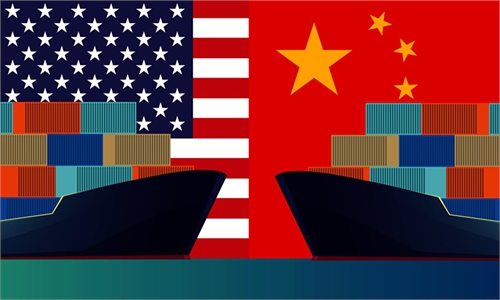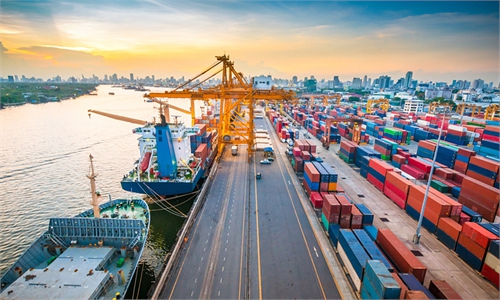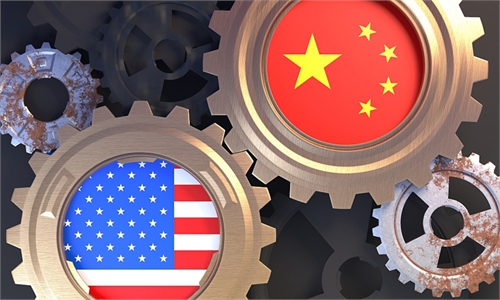China’s exports beat expectations in Sep despite rising challenges
Pressure remains, but solid growth expected

Two large ocean-going freighters load cars for export at a special automobile terminal at Lianyungang Port, East China's Jiangsu Province on Monday. Lianyungang Port opened a green channel this year for vehicle exports to ensure timely shipment. From January to July, 80,252 vehicles were exported at the port, up 71.8 percent year-on-year. Photo: VCG
China's export machine kept roaring in September with growth pace during the month significantly exceeding expectations, despite a series of challenges, including the lingering fallout of the COVID-19 pandemic, power shortages and price hikes for bulk commodities.The unexpected acceleration underlined strong resilience of the country's export sector and solid recovery in the world's second-largest economy; however, downward pressure and uncertainty remain for trade and economic growth in the rest of 2021, though solid growth pace is still expected, experts noted.
In September, China's exports grew 28.1 percent from the previous year, up 3.9 percentage points from August, data from the General Administration of Customs (GAC) showed on Wednesday.
That growth pace beat forecast in a Reuters' survey that put China's export growth at 21 percent in September due to slowed overseas demand and a weakened US economic recovery.
However, imports growth slowed significantly to 17.6 percent from 33.1 percent growth in the previous month. Still, China's overall trade rose by a solid 23.3 percent in the month, according to the GAC.
Li Kuiwen, an official at the GAC, attributed the sustained growth of foreign trade to the recovery of the Chinese economy.
"The long-term fundamentals of China's economy have not changed, and the steady domestic production and consumption demand have provided strong support for the growth of foreign trade," Li said.
In the first three quarters, foreign trade amounted to $4.3 trillion, rising 32.8 percent year-on-year. Exports rose 33 percent, while imports increased 32.6 percent.
The better-than-expected export data show that there is strong external demand for Chinese products, Cong Yi, a professor at the Tianjin University of Finance and Economics, told the Global Times on Wednesday.
"It also shows that foreign countries depend on Chinese products, especially daily necessities, which have high cost performance and strong international competitiveness, and cannot be replaced by those from other countries at the moment," Cong said.
A recovery in the global economy from the COVID-19 pandemic also helped boost China's exports. In the first three quarters, China's exports to the US and EU grew by over 30 percent year-on-year, and those to Latin America jumped 58 percent.
However, the statistics point to a slowing trend for the country's imports and exports. China's total trade grew by 15.2 percent in the third quarter in yuan terms, slowing from 25.2 percent in the second quarter and 29.7 percent in the first, the customs data showed.
Li said that there are both positive and negative factors impacting China's trade. On the one hand, China's economic growth would continue to support its foreign trade. But on the other, uncertainties remain over the coronavirus.
"Considering the high base effect of foreign trade last year, China's fourth-quarter trade growth may wane, but China is still expected to achieve fast growth in trade for the whole year," Cong said.
Experts attributed the growth slowdown to a number of factors, including the lingering power shortage, price surges of raw materials and the pandemic.
"China's exports are entering a downward channel as a result of easing overseas demand and a slowdown in the substitution effect, but the sector still has resilience at large, and the export slowdown could be managed in a stable manner," Wu Chaoming, chief economist at Chasing Securities, told the Global Times.
The expected slowdown in trade growth also pushed some analysts to anticipate more downward pressure on China's economic growth.
"The travail of economic transition has appeared," Wu said, estimating that GDP is likely to grow by about 5.6 percent in the third quarter, compared with 7.9 percent in the second quarter.
Chinese economists said the slowdown is reasonable given the extraordinarily fast growth at the second half of last year. They added that full-year GDP growth rate will still be very high.
In the latest global economic outlook report released on Tuesday, the IMF also estimated that China's GDP growth would be 8 percent for 2021 and 5.6 percent for 2022, in each case, a downgrade of 0.1 points from July's estimate.



